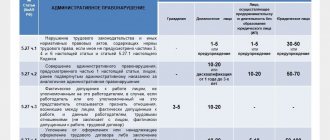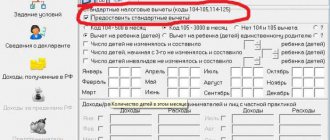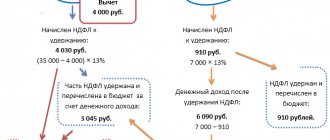Types of tax periods
According to paragraph 1 of Article of the Tax Code of the Russian Federation, the tax period is a period of time at the end of which the final tax base is determined and the final amount of tax is calculated, which must be transferred to the budget.
The specific tax period for each tax is established in Part 2 of the Tax Code (in the chapter devoted to the relevant tax). This period varies from a month to a year. The period of time at the end of which you need to calculate the total amount of the trading fee is called the taxation period, and the insurance premiums are called the settlement period.
Fill out, check and submit a new insurance premium calculation online for free
What is meant by tax period in Russia?
The tax period in Russia is a period of time after which the final tax base is drawn up, and the tax is calculated and paid from it (Clause 1 of Article 55 of the Tax Code of the Russian Federation).
In most cases, this period is equal to a calendar year, but can be a quarter or a month. In the Tax Code of the Russian Federation, a tax period of less than 1 year is established for a number of taxes. Thus, a quarterly tax period is defined for VAT (Article 163 of the Tax Code of the Russian Federation), water tax (Article 333.11 of the Tax Code of the Russian Federation), and trade tax (Article 414 of the Tax Code of the Russian Federation).
The shortest tax period, lasting only a month, is defined, for example, for taxes such as mineral extraction tax (Article 341 of the Tax Code of the Russian Federation) and excise taxes (Article 192 of the Tax Code of the Russian Federation).
Important! Explanations from ConsultantPlus The tax period is important not only for calculating tax, but also for tax legal relations in general, in particular: for the entry into force of tax changes (clause 1 of article 5 of the Tax Code of the Russian Federation); tax transfers. For example, in field “107” of the payment order you need to indicate the tax period code (clause 8 of Appendix No. 2 to Order of the Ministry of Finance of Russia dated November 12, 2013 No. 107n); ...correcting errors in calculating the tax base (clause 1 of Article 54 of the Tax Code of the Russian Federation)... Read more in K+. Trial access to the system is free.
But even the legally established period is not always the same length. Art. 55 of the Tax Code of the Russian Federation considers the following cases of lengthening and shortening the tax period:
- for newly formed companies or individual entrepreneurs, the moment of state registration of which is located between January 1 and December 31 (August 25, for example), the first tax period is shortened and is from 08/25/2021 to 12/31/2021 (paragraph 2, paragraph 2, article 55 Tax Code of the Russian Federation);
- for a company (or individual entrepreneur) registered in December (for example, 12/08/2021), the first tax period becomes longer than usual - from 12/08/2021 to 12/31/2022 (paragraph 3, paragraph 2, article 55 of the Tax Code of the Russian Federation);
- for organizations and individual entrepreneurs who decide to reorganize or even liquidate their business during the year, the last tax period will be shortened compared to the usual one; as a result, its duration will be, for example, from 01/01/2021 until the moment of reorganization or liquidation (paragraph 1, paragraph 3, article 55 of the Tax Code of the Russian Federation);
- if a company or individual entrepreneur was created in 2022 and was liquidated (reorganized) at the same time, then the tax period for them is the time period from the moment of state registration until the moment of liquidation (reorganization) (paragraph 2, paragraph 3, article 55 of the Tax Code of the Russian Federation);
- for a company (or individual entrepreneur) created in December 2022 (for example, 12/20/2021) and ceased operations in 2022 (for example, 12/30/2022), the tax period will be the time period from 12/20/2021 to 12/30/2022 (paragraph 3 clause 3 of article 55 of the Tax Code of the Russian Federation);
- for a foreign company that has recognized itself as a tax resident, the duration of the tax period depends on the date of recognition specified in the statement about this event (clause 6 of Article 55 of the Tax Code of the Russian Federation).
Similar rules apply for a tax period equal to a quarter. However, the time period that allows it to be extended is not equal to 1 month (December), as for a year, but to 10 days remaining until the end of the quarter (paragraph 3, clause 3.1, paragraph 3, clause 3.2, article 55 of the Tax Code of the Russian Federation).
How is the tax period determined?
We have compiled data on the duration of periods for all taxes, as well as insurance premiums and trading fees, into a table.
| Length of period | Tax name | Article of the Tax Code of the Russian Federation |
| Month | Excise taxes | 192 |
| MET | 341 | |
| Gambling tax | 368 | |
| Quarter | VAT | 163 |
| Water tax | 333.11 | |
| UTII | 346.30 | |
| Trade fee | 414 | |
| Year | Personal income tax | 216 |
| Income tax | 285 | |
| Tax on additional income from hydrocarbon production | 333.53 | |
| Unified agricultural tax | 346.7 | |
| simplified tax system | 346.19 | |
| PSN (if the patent is issued for a shorter period, the tax period is the period for which the patent was issued) | 346.49 | |
| Transport tax | 360 | |
| Organizational property tax | 379 | |
| Land tax | 393 | |
| Property tax for individuals | 405 | |
| Insurance premiums | 423 |
Submit all tax returns online for free
Salary reports
Reports on wages, insurance premiums and withholding taxes provide individual coding.
For the 6-NDFL report, a separate reporting period is provided - code 90, which indicates the year before the reorganization and (or) liquidation of the reporting company. Use a similar code to create a single calculation for insurance premiums. But if the organization reports in a standard mode, then the coding provided for indicating information on an accrual basis is used. For example, what period code 34 in the RSV is information for the year.
General values for salary reports:
- 21 - the first three months of the year: January, February, March;
- 31 - 1st half of the year or the first 6 months on an accrual basis;
- 33 – 9 months from the beginning of the year;
- 34 is a full calendar year, or 12 months from January to December.
The status and category of the taxpayer does not play any role. That is, organizations (legal entities), individual entrepreneurs, and ordinary citizens are required to use the code when drawing up the 3-NDFL declaration and other forms of fiscal reports and declarations.
It is worth noting that tax period code 34 in almost all types of reporting forms in the Federal Tax Service indicates a full calendar year (January-December). Please note that in reporting on transport tax, according to the simplified tax system, a unified calculation of insurance premiums and in other forms, the year is everywhere.
What is the difference between tax and reporting periods
In accordance with paragraph 1 of Article of the Tax Code of the Russian Federation, a tax period may consist of one or more reporting periods. For example, it could be a month, two months, three months, etc., first quarter, second quarter, third quarter, half a year, 9 months. At the end of each reporting period, the taxpayer determines the interim base and contributes the amount of the advance payment to the budget.
As you can see, tax and reporting periods differ in the basis for calculating the amount that needs to be transferred at the end of the corresponding period of time. For the reporting period, this is a kind of “incomplete” base. It can be calculated based on actual data on income, expenses or payments for an intermediate period of time. Or it can be conditional, that is, determined based on data for previous periods or by calculation method. As for the tax period, the payment is always calculated based on the real financial result for the corresponding period of time.
REFERENCE
There may be situations where the final tax will be less than the advance payments made during the year. In this case, the taxpayer will have an overpayment, which can be returned or offset (Article of the Tax Code of the Russian Federation).
Submit an application for credit or refund of taxes (contributions) via the Internet Submit for free
Under what circumstances can the tax period not be lengthened or shortened?
Taxpayers working under special tax regimes (Unified Agricultural Tax, Simplified Tax System, PSN) cannot use the rule of changing the duration of the tax period (clause 4 of Article 55 of the Tax Code of the Russian Federation).
Is it necessary to submit a declaration for the year if the organization registered on the simplified tax system only in December of this year? The answer to this question can be found in ConsultantPlus. Trial access to the system is provided free of charge.
For a tax period defined as a month, its duration is taken according to the actual number of days of the taxpayer’s existence in it, if such existence does not cover the entire period (clauses 3.3 and 3.4 of Article 55 of the Tax Code of the Russian Federation).
There is no provision for extension of the tax period for tax agents. It can only be reduced (clause 3.5 of Article 55 of the Tax Code of the Russian Federation).
Tax period codes for VAT
The following codes are used in the VAT declaration (Appendix No. 3 to the Procedure for filling out the declaration, approved by Order of the Federal Tax Service dated October 29, 2014 No. ММВ-7-3/ [email protected] ):
| 21 | I quarter |
| 22 | II quarter |
| 23 | III quarter |
| 24 | IV quarter |
| 51 | I quarter during reorganization (liquidation) of the organization |
| 54 | II quarter during reorganization (liquidation) of the organization |
| 55 | III quarter during reorganization (liquidation) of the organization |
| 56 | IV quarter during reorganization (liquidation) of the organization |
Also see “New VAT return form: how to submit reports for the first quarter quickly and without errors.”
Fill out, check and submit a new VAT return through Kontur.Extern Submit for free
Codes of tax periods according to the simplified tax system
The declaration under the simplified tax system uses the following codes (Appendix No. 1 to the Procedure for filling out the declaration, approved by order of the Federal Tax Service dated December 25, 2020 No. ED-7-3 / [email protected] :
| 34 | Calendar year |
| 50 | Last tax period for reorganization (liquidation) of an organization |
| 95 | Last tax period when switching to a different taxation regime |
| 96 | Last tax period upon termination of business activity |
Submit a free notification of the transition to the simplified tax system and submit a declaration under the simplified tax system via the Internet
Results
A payment order is a document used to transfer funds to the recipient. Field 107 “Tax period” is filled in when paying taxes or contributions and contains key information about the period for which the payment is made. The accuracy of identification of the payment by the regulatory authority and, as a consequence, the unambiguity of its assignment to the corresponding tax period depends on the correctness of filling out this field.
Sources:
- Tax Code of the Russian Federation
- Order of the Ministry of Finance of Russia dated November 12, 2013 N 107n
You can find more complete information on the topic in ConsultantPlus. Free trial access to the system for 2 days.
Codes of tax periods for income tax
The following codes are used in the income tax return (Appendix No. 1 to the Procedure for filling out the declaration, approved by Order of the Federal Tax Service dated September 23, 2019 No. ММВ-7-3/ [email protected] ):
| 21 | first quarter |
| 31 | half year |
| 33 | nine month |
| 34 | year |
| 35 | one month |
| 36 | two month |
| 37 | three months |
| 38 | four months |
| 39 | five months |
| 40 | six months |
| 41 | seven months |
| 42 | eight months |
| 43 | nine month |
| 44 | ten months |
| 45 | eleven months |
| 46 | year |
| 50 | last tax period during reorganization (liquidation) of the organization |
Fill out and submit a new income tax return online Submit for free
Deadline for submitting the report according to the DAM form
The quarterly calculation of insurance premiums is submitted to the tax authorities no later than the 30th day of the month following the reporting period. If the established day for submitting the report falls on a weekend, then in accordance with the law it is postponed to the first working day (clause 7, article 6.1 of the Tax Code of the Russian Federation).
For 2022, the following deadlines for providing quarterly calculations have been established:
- for 2022 until January 31, 2022 (the 30th is a day off)
- for the first quarter until May 4, 2022 (April 30 is a day off)
- half a year before August 1, 2022 (July 30th and 31st are weekends)
- 9 months before October 31, 2022
Entrepreneurs running peasant farms do not submit quarterly reports; the deadline for submitting the annual report is set, as for other organizations, no later than January 30 of the following year. But since the 30th falls on a Sunday, the deadline is moved to the next working day, January 31, 2022.
Tax period 34
Code 34 in most cases corresponds to a tax period equal to a calendar year. For example, this is the code that is entered in declarations for the simplified tax system, personal income tax and corporate property tax.
When filling out income tax reporting, you need to take into account the following nuance. In the annual return, code 34 is indicated by those taxpayers who submit returns quarterly. If the organization reports profit monthly, then the final declaration contains the number 46, which also indicates the year.
Main purpose
To indicate the specific period of time for which the fiscal reporting form was compiled, a special codification is provided. The code is a two-digit number, for example, 31 is the period in the tax return, 21 is in the DAM calculation, or 50 is in another form.
This codification is a very convenient grouping of reporting according to the time of its formation. For example, this code allows you to quickly determine for what period of time the taxpayer made the calculation and calculated the tax to the budget.
For each type or tax reporting code (TRR), an individual codification procedure is provided, indicating the code of the tax billing period in the document. Let's look at how codes are determined for the main types of reports to the Federal Tax Service.
The category and status of the taxpayer does not matter to determine the coding. That is, the Federal Tax Service approves codes individually for each form or report form, regardless of the type of payer of fees, contributions and taxes. That is, this coding is used by legal entities, individual entrepreneurs, private practices, and ordinary citizens.
Codes for the accounting reporting period in 2022
In accounting, the reporting period is the period for which the organization must prepare financial statements (clause 4 of PBU 4/99). For annual financial statements, this period is the calendar year - from January 1 to December 31 inclusive. An exception applies to cases of creation, reorganization (except transformation) and liquidation of a legal entity (Clause 1, Article 15 of the Federal Law of December 6, 2011 No. 402-FZ “On Accounting”).
ATTENTION
In financial statements, data on periods is not coded, but is indicated by entering the date, month and year.
The form of the balance sheet (approved by order of the Ministry of Finance dated July 2, 2010 No. 66n) does not provide for coding the reporting period. Specific reporting dates are indicated on the title page and in the table with indicators, rather than period codes. In the same way, that is, without using codes, data on periods is filled out in the form of the Statement of Financial Results.
Prepare, check and submit financial statements to the Federal Tax Service via the Internet Submit for free
Article 379 of the Tax Code of the Russian Federation. Taxable period. Reporting period (current version)
The tax period is a mandatory element of the corporate property tax. The commented article establishes that the tax period for this tax is a calendar year. Reporting periods are the first quarter, half a year and nine months of the calendar year.
At the same time, the relevant body of a constituent entity of the Russian Federation, when establishing a property tax, has the right to decide whether it will establish reporting periods or not.
Arbitrage practice.
The FAS Moscow District, in its Resolution dated August 1, 2012 in case No. A40-28009/10-78-105B, noted that according to the provisions of Article 379 of the Tax Code of the Russian Federation, the tax period for corporate property tax is the calendar year. Reporting periods are the first quarter, six months and nine months of the calendar year.
The date of occurrence of the obligation to pay tax is the date of the end of the tax period for taxes, the tax period for which consists of several reporting periods, based on the results of which advance payments are made; when deciding on the qualification of claims, the end dates of reporting periods are also taken into account.
Arbitrage practice.
The Federal Antimonopoly Service of the North Caucasus District in Resolution No. F08-4451/2006-1898A dated September 26, 2006 in case No. A22-239/2006/12-23 explained that Article 379 of the Tax Code of the Russian Federation provides that the tax period is a calendar year. Reporting periods are the first quarter, six months and nine months of the calendar year.
Thus, tax calculations for advance payments and tax returns are different documents for corporate property tax.
Arbitrage practice.
The Thirteenth Arbitration Court of Appeal, in its Resolution dated July 6, 2005 in case No. A56-4348/2005, noted that after the expiration of the calendar year, consequences associated with non-payment of tax occur. The calculation of advance payments for property tax is not a tax return in the sense of Article 80 of the Tax Code of the Russian Federation, therefore there are no grounds for applying liability under Article 119 of the Tax Code of the Russian Federation.
Arbitrage practice.
The Supreme Court of the Russian Federation, in Ruling No. 47-G06-18 dated May 17, 2006, explained that the Tax Code of the Russian Federation establishes reporting periods and advance payments as components of the tax period for certain types of regional taxes. Thus, the possibility of establishing reporting periods and advance payments is provided for in Articles 379, 383 of the Tax Code of the Russian Federation for the property tax of organizations.
Arbitrage practice.
The FAS Povolzhsky District in its Resolution dated April 29, 2008 in case N A57-14007/06-45 explained that both the numerator and the denominator of the fraction when determining the average annual value of property must contain data for all 12 calendar months of the year, and at the same time the denominator of the fraction must be increased by one unit, which corresponds to this legal norm. Thus, the denominator of the fraction will always be a constant value (the number of months in the tax (reporting) period), increased by one (13, 10, 7 and 4).
Attention.
The Federal Tax Service of Russia, in a letter dated July 24, 2013 N ED-4-3/ [email protected] , drew attention to the fact that the tax period for corporate income tax and corporate property tax, respectively, is the calendar year.
For tax purposes, the concepts of “year” and “calendar year” are different. According to Article 6.1 of the Tax Code of the Russian Federation, a year (except for a calendar year) is any period of time consisting of 12 consecutive calendar months.
Attention.
The Ministry of Finance of the Russian Federation in a letter dated February 24, 2012 N 07-02-06/28 indicated that the first tax period for an organization created in the period from December 1 to December 31 is the period from the date of creation to the end of the calendar year following the year creation (clause 2 of Article 55 of the Tax Code of the Russian Federation).
The average annual value of the property of a newly created organization is calculated in the manner established in paragraph 4 of Article 376 of the Tax Code of the Russian Federation, based on the residual value of the property on the 1st day of each month of the calendar year and the last day of the calendar year.
In this regard, when transforming one legal entity into another legal entity in a calendar year, the created legal entity is required to submit a tax return on the property tax of organizations for the tax period from the date of registration to the end of the calendar year.
Attention.
The Ministry of Finance of the Russian Federation in a letter dated July 15, 2011 N 03-05-05-01/55 explained that when calculating the average annual (average) value of property for the tax period, the residual value of the property reflected in the the organization’s balance sheet as of the 1st day of each month, starting from January 1 and the residual value of the property at the end of the calendar year, that is, the residual value of the property reflected in the financial statements for the reporting year at the end of the year, taking into account the relevant transactions performed on December 31 of the calendar year , indicating the presence and movement of fixed assets and their residual value.
Attention.
The Federal Tax Service of Russia, in a letter dated July 30, 2013 N BS-4-11/13835, noted that if the tax base for property tax is the annual average (i.e., the average for a calendar year, and not the average for the period of activity of an organization or its separate division, having a separate balance sheet) the value of the organization’s property, then when determining it, as well as when determining the average value of property, the total number of months in the calendar year, as well as in the corresponding reporting period (i.e., quarter, half-year and 9 months of the calendar year) must be taken into account.
Attention.
The Federal Tax Service of the Russian Federation, in a letter dated November 11, 2010 N ШС-37-3/15203, drew attention to the fact that the tax base for property tax is the average annual (that is, the average for a calendar year) value of the organization’s property, when determining it, as well as when determining The average value of the property must take into account the total number of months in the calendar year, as well as in the corresponding reporting period (that is, the quarter, half-year and ten months of the calendar year).
Consequently, the calculation of the average annual value of the property of the reorganized organization is carried out in accordance with the generally established procedure, taking into account Article 379 of the Tax Code of the Russian Federation.
Attention.
The Federal Tax Service of the Russian Federation for Moscow, in a letter dated 06/07/2008 N 09-14/054957, interpreting Article 379 of the Tax Code of the Russian Federation, noted that the tax base for property tax is the annual average (that is, the average for the calendar year, and not the average for the period of activity organization) the value of the organization’s property; when determining it, the total number of months in the calendar year should be taken into account.
Comment source:
“ARTICLE-LINE COMMENTARY TO CHAPTER 30 OF THE TAX CODE OF THE RUSSIAN FEDERATION “PROPERTY TAX OF ORGANIZATIONS”
Yu.M. Lermontov, 2014






